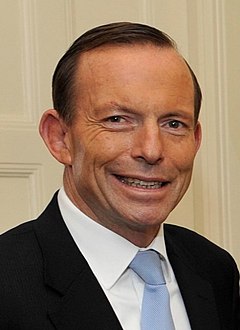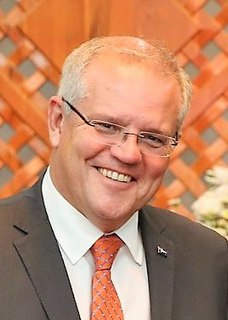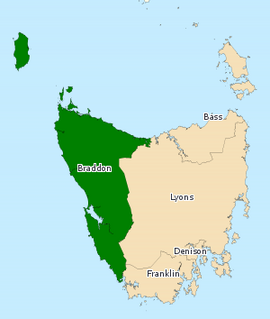
The Australian electoral system comprises the laws and processes used for the election of members of the Australian Parliament. The system presently has a number of distinctive features including compulsory enrolment, compulsory voting, majority-preferential instant-runoff voting in single-member seats to elect the lower house, the House of Representatives, and the use of the single transferable vote proportional representation system to elect the upper house, the Senate.

The 1996 Australian federal election was held to determine the members of the 38th Parliament of Australia. It was held on 2 March 1996. All 148 seats of the House of Representatives and 40 seats of the 76-seat Senate were up for election. The centre-right Liberal/National Coalition led by Opposition Leader John Howard of the Liberal Party and coalition partner Tim Fischer of the National Party defeated in a landslide the incumbent centre-left Australian Labor Party government led by Prime Minister Paul Keating.

The Australian Electoral Commission (AEC) is the independent federal agency in charge of organising, conducting and supervising federal Australian elections, by-elections and referendums.
Antony John Green is an Australian psephologist and commentator. He is the Australian Broadcasting Corporation's election analyst.

The Division of Fenner is an Australian Electoral Division in the Australian Capital Territory and the Jervis Bay Territory. As of the 2018 redistribution, it includes Gungahlin and the part of Belconnen north of Belconnen Way and west of Eastern Valley Way, Aikman Drive and William Slim Drive. It also includes the Jervis Bay Territory.

The Division of Canberra is an Australian electoral division in the Australian Capital Territory. It is named for the city of Canberra, Australia's national capital, and includes all of central Canberra, Kowen, Majura, as well as part of Weston Creek, Woden Valley, Molonglo Valley, Belconnen, and Jerrabomberra. It is currently held by Alicia Payne of the Labor Party.

Brunswick East is an inner-city suburb 5 kilometres north from Melbourne's central business district. Its local government area is the City of Moreland. At the 2016 Census, Brunswick East had a population of 11,504.

Elections to the Australian Capital Territory Legislative Assembly were held on Saturday, 20 October 2001. The incumbent Liberal Party, led by Gary Humphries, was challenged by the Labor Party, led by Jon Stanhope. Candidates were elected to fill three multi-member electorates using a single transferable vote method, known as the Hare-Clark system. The result was another hung parliament. However Labor, with the largest representation in the 17-member unicameral Assembly, formed Government with the support of the ACT Greens and Democrats. Stanhope was elected Chief Minister at the first sitting of the fifth Assembly on 12 November 2001. The election was conducted by the ACT Electoral Commission and was the first time in Australia's history that an electronic voting and counting system was used for some, but not all, polling places.
This is a list of electoral results for the Division of Bennelong in Australian federal elections from the electorate's creation in 1949 until the present.

The 2010 Australian federal election was held on Saturday, 21 August 2010 to elect members of the 43rd Parliament of Australia. The incumbent centre-left Australian Labor Party led by Prime Minister Julia Gillard won a second term against the opposition centre-right Liberal Party of Australia led by Opposition Leader Tony Abbott and Coalition partner the National Party of Australia, led by Warren Truss, after Labor formed a minority government with the support of three independent MPs and one Australian Greens MP. As of 2020 this remains the last federal election victory for the Labor party.
The Communist Alliance was registered on 16 March 2009 with the Australian Electoral Commission (AEC) as an Australian political party. It was an alliance of a number of Communist groups, individuals and ethnic based Communist Parties. The Alliance was formed to allow communists to run in elections under the Communist banner, while allowing the Communist Party of Australia, a member of the Alliance, to retain a separate, independent membership.

The 2013 Australianfederal election to elect the members of the 44th Parliament of Australia took place on 7 September 2013. The centre-right Liberal/National Coalition opposition led by Opposition leader Tony Abbott of the Liberal Party of Australia and Coalition partner the National Party of Australia, led by Warren Truss, defeated the incumbent centre-left Labor Party government of Prime Minister Kevin Rudd by an 18-seat 3.6 percentage point two-party swing resulting in a landslide win for the Coalition. Labor had been in government for 6 years since first being elected in the 2007 election. This election marked the end of the 6-year Rudd-Gillard-Rudd Labor government and the start of the current Abbott-Turnbull-Morrison Liberal-National Coalition government. Abbott was sworn in by the Governor-General, Quentin Bryce, as Australia's new Prime Minister on 18 September 2013, along with the Abbott Ministry and the members of the House of Representatives. The 44th Parliament of Australia opened on 12 November 2013, which is taken to be the commencement of the term of members of the House of Representatives. The new senators were sworn in by the next Governor-General Peter Cosgrove on 7 July 2014, with their six-year terms commencing on 1 July.
This is a list of electoral results for the Division of Canberra in Australian federal elections from the division's creation in 1974 until the present.
The Australian Independents was a political party in Australia, founded by serial election candidate Patricia Petersen in 2012. The party was registered with the Australian Electoral Commission on 16 July 2013.

The following tables show state-by-state results in the Australian Senate at the 2013 Australian federal election.

The Australian Equality Party (Marriage) was an Australian political party founded by Jason Tuazon-McCheyne. The AEP had a platform that promoted equality and human rights, particularly in relation to the gay, lesbian, bisexual, transgender, intersex and queer (GLBTIQ) community. The party's goal was to get AEP Leader, Jason Tuazon-McCheyne, elected to the Senate at the 2016 Federal Election. The party was deregistered voluntarily on 26 March 2018.

The 2019 Australian federal election was held on Saturday 18 May 2019 to elect members of the 46th Parliament of Australia. The election had been called following the dissolution of the 45th Parliament as elected at the 2016 double dissolution federal election. All 151 seats in the House of Representatives and 40 of the 76 seats in the Senate were up for election.

The 2020 Australian Capital Territory general election was held between 28 September and 17 October 2020 to elect all 25 members of the unicameral ACT Legislative Assembly.

A by-election for the Australian House of Representatives seat of Braddon took place on Saturday 28 July 2018, following the resignation of incumbent Labor MP Justine Keay.

In Australia, voter registration is called enrolment. Enrolment is a prerequisite for voting at federal elections, by-elections and referendums, as well as all state and local government elections; and it is generally compulsory for enrolled persons to vote unless otherwise exempted or excused. Enrolment is compulsory for Australian citizens over 18 years of age who have lived at their current address for at least one month. Enrolment is not compulsory for persons with no fixed address who are not already enrolled. Residents in Australia who had been enrolled as British subjects on 25 January 1984, though not Australian citizens, continue to be enrolled, and cannot opt out of enrolment. For local government elections, an elector generally does not require to be an Australian citizen. Once enrolled, a person cannot opt out of enrolment. Enrolment is optional for 16 or 17-year olds, but they cannot vote until they turn 18, and persons who have applied for Australian citizenship may also apply for provisional enrolment which takes effect on the granting of citizenship.

















